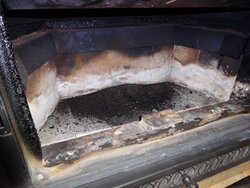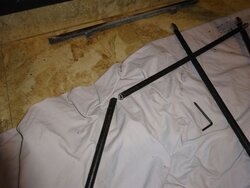I have used mine for three cleanings now. The second time, I broke one rod. The instructions say to keep it moving up and down whilst spinning. I was holding the rod in place with gloved hand, and stopped the up-and-down motion for a moment, and it broke right where I was holding it. The rod was bent less than 90 degrees, so after that I was always careful to stop the drill before pausing the up-and-down motion even briefly. They include that caution in the instructions for a reason.
My chimney is 6" double-wall SS, installed inside the chase left by the 150 y.o. interior masonry chimney that I completely took down because the bricks were crumbling and turning back to clay dust. The chase is closed off from the rooms of the house, so I don't worry too much about creosote and soot dust. I found the piece of plastic sheet totally useless, and just ran the thing without it, with a pan at the bottom to catch most of the soot as it fell out. But I quickly noticed a problem and immediately stopped the drill and pulled out the Sooteater. The sharp edge of the inner wall at the bottom the insulated tee, right where the cap fits, was cutting into the black plastic jacket on the Sooteater rod. If I had not stopped when I did, it would have completely chewed up the jacket. I don't think the plastic sheet would have helped in the slightest to keep the spinning rod away from that sharp edge.
Here's my solution: I cut out a round disc the same size as the insulated tee cap from a piece of 1/2" plywood. I cut an oval shaped hole in the plywood, offset towards one side of the disc, but far enough away from the sharp edge to assure that the rod could not come in contact with it. Using a rasp, I rounded off the sharp edges on the plywood all way round the perimeter of the hole. I fabricated a bracket to hold the disc in place, taking advantage of two holes that the manufacturer had drilled in the support plate, which allows me to screw it in place. I connect one rod to the brush, slide the wooden disc over the rod and then insert the disc into the tee, where the tee cap goes and secure it with the bracket. That keeps the rod more or less centred at the exit from the bottom of the tee, and away from that sharp edge. After multiple uses, about the only thing the plywood has done to the plastic jacket on the rods is to dull the sheen; I can see no gouges or other damage. The wooden disc also contains most of the fallen soot and creosote inside the bottom of the tee, and most of what does filter down through the hole in the disc, falls directly into the pan I have placed below. When I remove the disc, the rest falls into the pan. I don't remove the disc from position until I am down to the last rod, the one attached to the brush.
I believe the red string the factory uses is nothing but red weedwacker string. I have a roll of the latter, and it appears to be exactly the same material the same diameter. I plan to use that whenever I finally have to replace the string on mine.
I don't like to climb up on my slippery metal roof, so I had a chimney sweep come at the end of second burning season to check out the chimney and cap, and he cleaned everything from top down. After he finished, I inspected the interior of the flue pipe, and it didn't look any cleaner than it does after I do it myself with the Sooteater, but at least I know the cap is clean. I don't worry so much about igniting creosote at the very top above the roof where the cap is attached, but I don't want the vent holes to get stopped up either.








